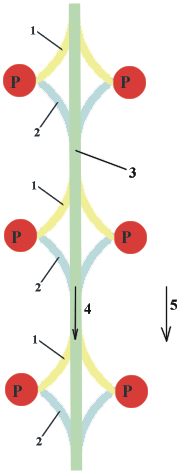
Fig.3
Alexander A.Shpilman (
sah@nursat.kz )Ring Structures of "Axion Fields"
|
|
In the beginning we shall determine the classification of the "axion field".
1) The "axion field" of sort 1 - unidirectional movement of positive pseudo-charges (Fig.1).
2) The "axion field" of sort 2 - unidirectional movement of negative pseudo-charges (Fig.1).
33) The "axion field" of sort 3 - with counter movement of opposite pseudo-charges (Fig.2).
4) The "axion field" of sort 4 - with the unidirectional movement of opposite pseudo-charges (Fig. 3), where 5 - the direction of movement of pseudo-charges.
|
|
|
|
Fig.1 |
Fig.2 |
Let's close a field of sort 4 in a ring (see Fig.4). During the experiment which was described in "Separation Axion (Spin) Field" at formation of the field of sort 4 the formation of interference strata in environmental space was observed. We can expect an occurrence of interference ring strata and in our case it is shown in a Fig.5. A chain of interference ring strata we shall name as a field of sort 5. The distance between rings and the diameter of rings will probably depend on the pulse-frequency characteristics of fields forming the basic ring of a level 0.
|
Fig.4 |
|
Up to what minimal sizes the rings of the field of sort 5 can be compressed?
In the article "Model of Structure Electron and Muon" I.M.Motora offers a ring model of electron and muon where the charges move on a ring with the speed of light. It reminds ring short circuit of the field of sort 2 with the unidirectional movement of pseudo-charges. The calculated radius of an electron ring is equal to 3.866E-13 m, and muon's radius is equal to 1.870E-15 m. I.e., muon's mass is approximately more than mass of electron in 200 times, and accordingly this the muon's radius is less approximately in 200 times. The more is the mass of a particle, the less is the radius of a ring.
If this model can be applied to a proton, prospective radius of a ring of a proton will be less than radius of a ring electron approximately in 2000 times, i.e. will be about 1.8E-16 m. Only it already will be the unidirectional movement on a ring opposite pseudo-charging (field sort 4).
The characteristic distance from the basic ring of the level 0 up to interference ring of strata of the level 1, and also the diameter of the last one, probably will be about length of a de Broil wave for moving electrons and protons. For motionless particles the characteristic sizes, probably, will be also about length of the de Broil wave in a potential field. The characteristic sizes will be determined by energy level (in atom) where a particle is, and by value of an energy potential of a particle in a place of observation of interference ring strata.
So for an electron in atom, the interference ring strata of the level 1 will have the size typical for the sizes of atom (~10-10 m), the interference ring strata of the level 2 will have the size typical for interatomic distances etc.
So for a proton in atom, the interference ring strata of the level 1 will have the size typical for the sizes of atomic nucleus (~10-15 m), the interference ring strata of the level 2 will have the size typical for the sizes of atom (~10-10 m) etc.
Apparently, in the interference ring strata of the level 1 of a proton in the atomic nucleus, an electron is included, in result a particle of a p-meson is formed. Thus, the size of the basic ring of the level 0 of electron decreases up to the sizes of interference ring strata of the level 1 of proton in the atomic nucleus and it will be, probably, a muon already. Probably, at decay of the atomic nucleus, such p-meson with a proton form an astable particle - a neutron.
If these guesses are correct, the generator described in "The Generator of the "Axion Field " Sort 5", can have strong influence on atom's structure.
In connection with told, there is a following interesting idea:
It is known for a long time already, that, in a mesonic atom (an atom in which the electron is exchanged with a muon) a temperature of a crystalline lattice is capable to influence to nuclear-force responses. It is possible to assume that there will be also a converse effect - excitation energy of the atomic nucleus can be transmitted to a crystalline lattice (if the last one will not be destroyed by this). I.e., probably, thus it is possible to stabilize a radionuclide (meson coolings of a nucleus) if it will be possible to stabilize a mesonic atom itself.
Probably, it can be reached, if it will be possible to receive requirements, which are favorable for formation of the closed ring structure of undirectional drift pseudo-charges in the crossed electromagnetic fields in a neighbourhood of a nucleus. The same things are occurring in the generator described in "The Generator of the "Axion Field " Sort 5". The necessary magnetic strength in neighbourhoods of a nucleus can be tried to reach, selecting a crystalline structure with the relevant intracrystalline magnetic field. In these requirements, the usual atoms will transfer self-maintainedly in a state to a similar mesonic atom without an exterior irradiation by muons.
This idea can allow not only stabilize nucleus and transuranium nucleus, but also probably will give new radiants of energy, if the idea enunciated in "Decay spontaneous?" is correct.
Because it is not easy to achieve the necessary magnetic strength in a neighbourhood of the atomic nucleus, development of generators of the field of sort 5 has major value.